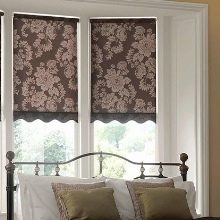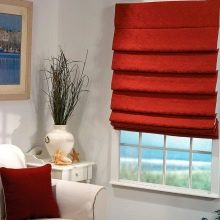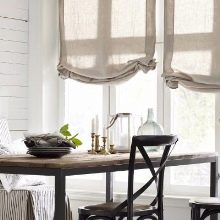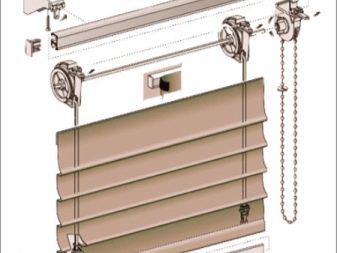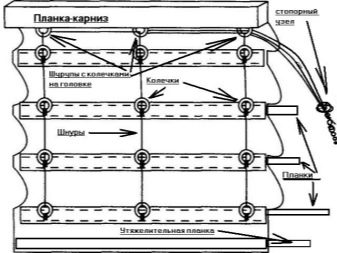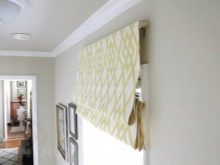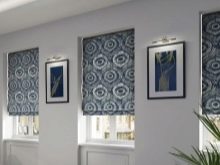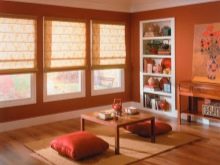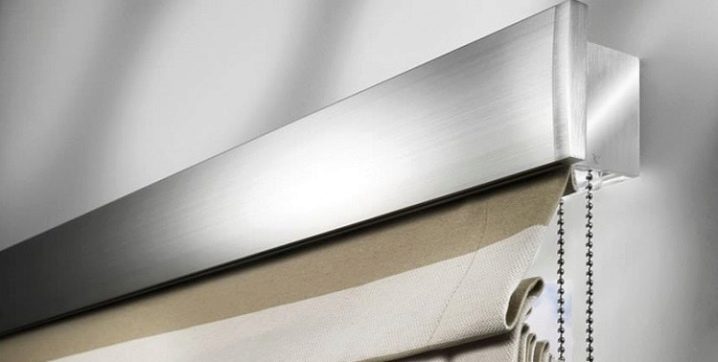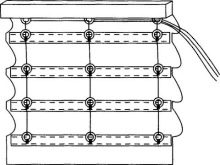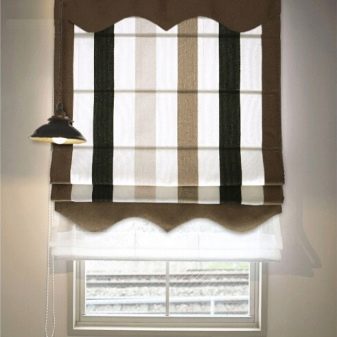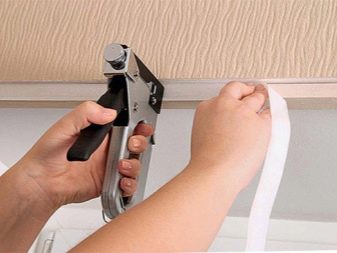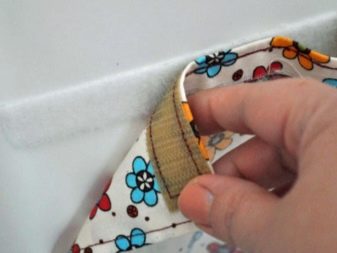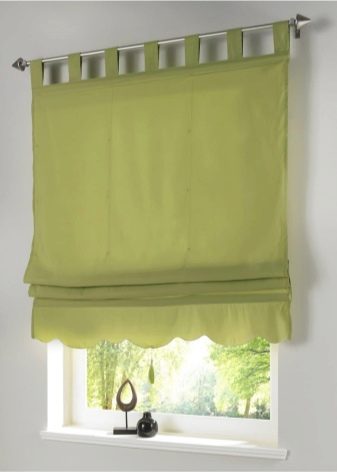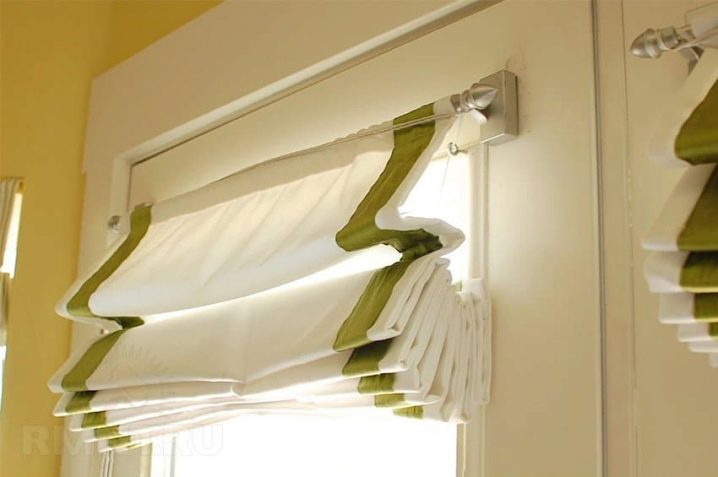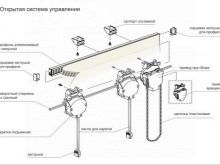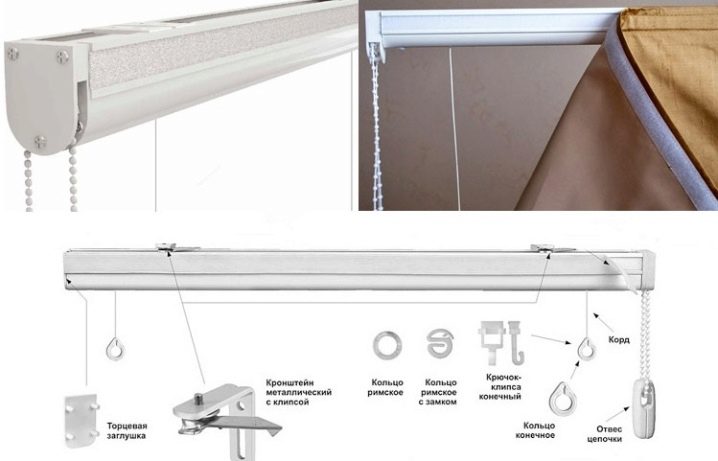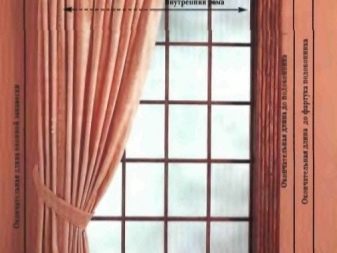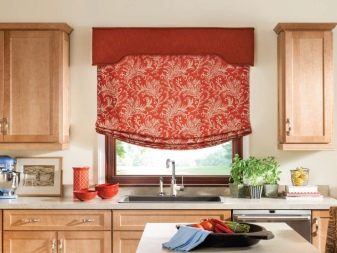How to fasten Roman blinds?

What kind of window decoration can be as simple in daily use as blinds and as elegant as elegant draperies of long curtains? This, of course, Roman blinds. Appearing about 2000 years ago in ancient Rome, they are relevant to this day.
Construction and mechanisms
Roman blinds are a cloth most often even and proportionate to the window frame or window opening in expanded form, which, when opened, is gathered at the top of the window in horizontal folds due to the lifting mechanism and the special design of the curtain itself. When raising and lowering such a curtain can be stopped at any level horizontally.
Such curtains come in three forms:
- Classic - in the unfolded and in the folded state are a flat canvas with even folds, formed by cords. Suitable for laconic and elegant interiors.
- Cascading - in any position form folds or draped waves cascading.
- Frameless - in the folded state sag in graceful arcs, since they do not have a cord in their design, but are pierced with thin threads.
The curtain consists of several parts:
- Clothdivided into equal horizontal stripes by rings sewn in a certain order (frameless version) or wooden or plastic strips sewn into the fabric. With the help of slats, horizontal folds are formed, without sagging. The width of the folds depends on the thickness of the fabric. To keep the curtain at the bottom not bristling and hanging evenly across the width, a special heavy bar is placed at the bottom of the cloth.
- Cornice - This is a device for fixing the curtain web. These control mechanisms are manual, mechanical or automatic.
Types of fastening
For mounting such curtains on the windows take into account various factors.
According to the location of this type of curtains can be divided into 3 options:
- Ceiling mount.
- Wall.
- Windowed.
To decide which arrangement to use, you must determine which tasks the decoration data for the room should perform:
- If you want to use a window sill even with curtains lowered as a workplace or a place of rest, as a shelf for exposing your collection of objects or colors, then you should choose curtain fixtures such as window fasteners. The fabric is attached directly to the window frame and does not close the sill when lowering. The same option is suitable for plastic windows with front opening for ventilation, and will not interfere with the opening of any window.
This option is also used in the combined design of the window, when other types of curtains are added to the Roman ones.
- If you need to cover the slopes of the window from the view of a stranger or visually expand the size of the window, then the wall mount is suitable when the cornice is attached above the window opening on the wall. This option is suitable for large windows and when the curtain is the only decoration of this window, and no other draperies are supposed to be used. Also, this option is suitable for mounting electroeaves.
- When it is intended to hang heavy long curtains, as well as close several windows at once or the entire wall, a ceiling mount will be suitable for such a solution. These types of fasteners often involve the installation of an eaves with electric drive.
There are two types of fastening: using the eaves and installation without eaves.
With the eaves
The eaves is the mechanism intended for fastening of a cloth of fabric. Usually it comes with curtains. But when you sew curtains yourself or to order, the eaves for such curtains can be bought or ordered separately. If you install Roman blinds with the help of a cornice, then you need to think about what window shape, what size these curtains are for and then choose the type and type of the cornice.
Depending on the type, there are 3 types of cornices:
- Manual control. Manually lift the folds using a rope (cord) mechanism, threaded into special rings, sewn from the inside out at a certain distance along the entire length. This is the easiest to use mechanism, suitable for curtains of small size and weight not exceeding 5 kg. It is easy to make yourself using cords and rings.
- Mechanical. Mechanical control is a chain-rotary mechanism, equipped with a lifting shaft, which is set in motion and lifts the folds with the help of a chain. With it, you can lift curtains weighing up to 8 kg.
- Electro carne. The automatic lifting mechanism with electric drive is similar to the chain-rotary, only equipped with a motor and the opening of the curtains takes place with the help of a remote control. The electric carnival is suitable for any kind of curtains, even heavy and large-sized ones, and allows them to be used on the highest, hard-to-reach windows.
On sale ready eaves happen three types:
- Mini. The smallest ones are designed for curtains of small size for fixing them on one window sash of a double-glazed window or window frame of a blind window. Most often, these curtains are attached to the sewing velcro, as their small weight and size allows you to use this type of fastening even without drilling holes on the frame.
- Classic. Designed for more curtains, withstand the size of the canvas with a width of 1.5 meters and a height of 1.8 meters. They are fixed mainly on the wall and on the ceiling, but can also be attached to the frame.More often than others, this type of eaves is equipped with an electric drive.
- Skos. Designed for non-standard windows (arched windows, diamond-shaped, trapezoidal, round) and windows with an inclined surface, for example, roof windows. Two guides (at the top and bottom of the canvas) keep it on the roof window, even when it is opened. Such eaves are intended for curtains weighing no more than 3 kg.
When self-tailoring, it is better to use a velcro fastener than hinges or a pipe eaves so that the curtains do not slide down the inclined surface.
If the size of your window exceeds 1.8 m in width, then you will have to order a special cornice in the workshop and fix it on the ceiling, for greater reliability, it is best for an electric carnie.
Assembly without drilling
Any fastening with the help of a cornice, both mechanical and electro-eaves, presupposes the formation of holes in the window frame or on the walls and ceiling, since all of them are fastened with screws and require drilling of the holes for the fasteners. This can be avoided by applying alternative mounting options.
This installation method is used, such as fastening on a special textile sewing velcro.Adhesive tape "Velcro" is glued either on the window frame or on the wall, and it is attached to the canvas or glued too. So you can do without drilling the plastic frame. Then it is best to use light weight curtains, since installing them on velcro loses its reliability and durability over time.
When the product is sewn independently, it is advisable to use the existing eaves and fasten the fabric on it with hinges sewn along the upper edge or nail it with a furniture stapler. The disadvantages of these methods are obvious, as the design often looks less aesthetic and it is possible to fix the canvas with brackets without damage only once.
Fastening on the hinges is also not very convenient, since the canvas may sag due to the uneven distribution of the loops on the round cornice or roof rails and when the curtain is fixed using hinges, it is not very easy to remove the canvas from the cornice.
It is possible to shoot a strip of adhesive tape with a stapler on the existing cornice, and to fasten the curtains to the velcro. Then the curtain is simply removed for washing, and you can also hang another curtain in its place.
A homemade curtain can also be installed on a round cornice with the help of a drawstring - threading the cornice-tube through the hemmed top edge of the curtain, as well as sewing it around the cornice directly on the window. However, in order to remove such a laundry product, you will have to remove the cornice along with the curtain. With these types of fasteners will not fit the electrocarnit. Here you can use only the rope mechanism for manual lifting or mechanical in the form of a block on which the chain is wound. One end of the rope here is fixed on the block, and the other at the bottom of the canvas.
Installation Instructions
When installing the curtains using the eaves, tools such as a drill or a screwdriver, a tape measure and a pencil will be useful. This instruction is suitable for installing the eaves directly on the frame of a plastic window, and when you need to attach it to a wall or to the ceiling.
To install the eaves:
- Mark with the help of a tape measure and a pencil the place necessary for fixing the eaves. When you need to attach the curtain to the wall above the window opening, then draw a line parallel to the window sill. If the cornice is attached to the ceiling, then the installation of the cornice should be flush or parallel to the edge of the window opening.When installing a double Roman curtains need to mark the attachment points, given the width of the double eaves.
When placing double roman blinds, more space will be needed, so double roman blinds are best attached to the wall or to the ceiling.
- Drill drill the necessary holes in the attachment points (in the wall - if the curtain rod needs to be attached to the wall, in the ceiling - if it is attached to the ceiling or in the frame of the window frame closer to the outside corners - if you install the cornice on the frame of the plastic window).
- Use screws for mounting brackets. Brackets in the shape of the letter “G” are attached to the finished curtains with chain or rope lifting control mechanisms.
- Fasten the assembled curtain on the eaves according to the instructions using special clips or velcro.
If the curtains are easy to raise and lower, then everything is done correctly. To check this on curtains with manual or mechanical lift, you need to pull the cord or chain, lift the curtain to the desired height and fix, moving the control thread or chain to the side. The curtain should be fixed at the desired height exactly horizontally.To lower the curtains, also pull the cord to the side, the locking mechanism will release the fabric, and you can move the canvas further along the window up or down.
When using a special eaves for double Roman curtains, make sure that both panels lift independently from one lifting mechanism. This mechanism is designed to lift each panel separately.
If the lifting mechanism is electrically operated and you are not confident in your abilities to assemble the eaves according to the instructions, then it is better to entrust the installation to a specialist.
Nuances of fixing
If you have never encountered the installation of a Roman curtain or sewed it yourself and want to install it yourself, then you need to take into account certain tricks of fixing this type of curtain:
- The top of the canvas, when assembled, has a “deaf” zone, since the fabric is not assembled under the very eaves, as, for example, in horizontal blinds. And this strip of fabric can interfere when opening windows. Therefore, when marking up to install the eaves, it is necessary to take into account the measurement of the distance from the upper edge of the window, equal to the width of the fold and move this distance upwards when marking.
Alternatively, for such window openings, you can choose to place the curtain over the window sash or attach it to the ceiling.
- To fasten the curtain rail to the window frame, most often you need to mount on the screws. In this case, the integrity of the plastic window is violated. You can use other options - adhesive tape, double-sided tape, but these mounting options are short-lived compared to screws.
- When installing is very important the correct measurement of the window. Before buying or sewing, you need to decide how you will hang the curtain - inside the window opening or on the wall, blocking it. For any kind of installation, you need to measure - accurately measure the width and height of the window opening or the window itself, or its shutters.
Width should be measured in three places: above, below and in the middle. Curtain width should not be wider than the smallest of these three values. Then the curtain will move smoothly even in the window opening.
- If you have oblique-shaped windows, then the curtain can be fixed both inside and over the window opening.
- Use the appropriate type of anchoring depending on all the factors of your room and window.
- Decide on the style of the room, with the appointment of curtains, with their number for one window. Consider the width and severity of the fabric,make the necessary measurement of the window opening and choose the necessary type of fastening the curtains on the window - on the frame or in the window opening, on the wall or on the ceiling, with or without a cornice, double cornice or normal, with which lifting mechanism - manual, mechanical or electric. For each option curtains fit the best method of attachment.
Options for window design with Roman blinds set - the choice is yours.
About how to install Roman blinds, see this video.
